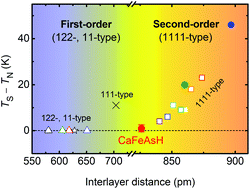Phase transition in CaFeAsH: bridging 1111 and 122 iron-based superconductors†
Abstract
Iron-based superconductors can be categorized into two types of parent compounds by considering the nature of their temperature-induced phase transitions; namely, first order transitions for 122- and 11-type compounds and second-order transitions for 1111-type compounds. This work examines the structural and magnetic transitions (ST and MT) of CaFeAsH by specific heat, X-ray diffraction, neutron diffraction, and electrical resistivity measurements. Heat capacity measurements revealed a second-order phase transition that accompanies an apparent single peak at 96 K. However, a clear ST from the tetragonal to orthorhombic phase and an MT from the paramagnetic to the antiferromagnetic phase were detected. The structural (Ts) and Néel temperatures (TN) were respectively determined to be 95(2) and 96 K by X-ray and neutron diffraction and resistivity measurements. This small temperature difference, Ts − TN, was attributed to strong magnetic coupling in the inter-layer direction owing to CaFeAsH having the shortest lattice constant c among parent 1111-type iron arsenides. Considering that a first-order transition takes place in 11- and 122-type compounds with a short inter-layer distance, we conclude that the nature of the ST and MT in CaFeAsH is intermediate in character, between the second-order transition for 1111-type compounds and the first-order transition for other 11- and 122-type compounds.



 Please wait while we load your content...
Please wait while we load your content...